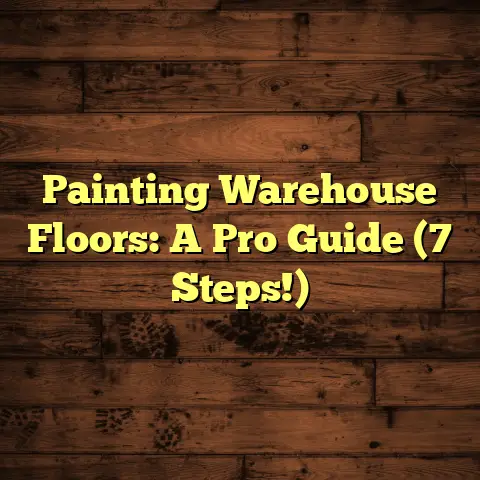How to Float a Floor Level? (4 Common Errors!)
I’m a flooring contractor, and I get it. The thought of transforming your living space with new flooring is exciting!
You envision a beautiful, comfortable, and safe environment, a place you’re genuinely proud of.
But let’s be real, home improvement projects can feel like a rollercoaster, right?
The initial excitement can quickly turn into frustration when you hit unexpected snags.
I remember one homeowner, Sarah, who was so pumped to install new hardwood floors.
She’d spent weeks picking out the perfect shade and grain. The day the wood arrived, she was practically bouncing off the walls!
But then she discovered her subfloor was anything but level. The dream of a flawless floor seemed to slip away.
That’s where “floating” a floor comes in.
It’s a technique used to create a smooth, level surface for your new flooring, and it can be a lifesaver.
But trust me, it’s not always smooth sailing.
I’ve seen my fair share of mistakes that can turn this seemingly simple process into a real headache.
So, in this article, I’m going to walk you through the ins and outs of floating a floor, sharing my expert knowledge and real-world experiences.
I’ll also highlight four common errors that I see homeowners make, so you can avoid them and achieve the beautiful, level floor you’ve been dreaming of.
Let’s dive in!
Section 1:
Understanding Floor Leveling
Okay, so what exactly does it mean to “float” a floor?
Basically, it’s the process of creating a level surface over an existing subfloor that may be uneven.
Think of it as building a new, smooth foundation for your new flooring.
Why is this so important?
Well, a level floor is crucial for several reasons.
For starters, it ensures that your flooring looks its best. Nobody wants to see dips or bumps in their beautiful new hardwood or tile.
A level floor also prevents accidents. Uneven surfaces can be tripping hazards, especially for kids or older adults.
And let’s not forget about the long-term health of your flooring.
Unevenness can put stress on certain areas, leading to premature wear and tear, or even cracking.
Different Methods of Floating a Floor
There are a few different ways to float a floor, depending on the severity of the unevenness and the type of flooring you’re installing.
-
Self-Leveling Compound (SLC): This is a pourable mixture that spreads out and hardens to create a smooth, level surface. It’s ideal for larger areas with significant unevenness.
-
Traditional Techniques: These involve using shims, plywood, or other materials to build up low spots and create a level surface. These are typically used for smaller, localized areas.
I’ve personally used both methods extensively, and each has its pros and cons.
SLC is faster and easier for large areas, but it can be more expensive.
Traditional techniques are more labor-intensive, but they can be more cost-effective for smaller jobs.
Why Float a Floor?
So, why might you need to float a floor in the first place?
Here are a few common reasons:
-
Settling: Over time, houses can settle, causing floors to become uneven.
-
Moisture Issues: Moisture can warp subfloors, leading to unevenness.
-
Uneven Subfloors: Sometimes, subfloors are simply not installed correctly in the first place.
I’ve seen it all, from floors that slope noticeably to floors that have hidden dips and bumps.
And trust me, ignoring these issues can lead to major problems down the road.
The Emotional Stakes
Let’s talk about the emotional side of this.
A level floor isn’t just about aesthetics and safety. It’s about feeling good in your home.
Think about it: when your floors are level, your furniture sits properly, your rugs lay flat, and your space just feels more cohesive and inviting.
On the other hand, uneven floors can create a sense of unease and discomfort.
You might find yourself constantly adjusting furniture or worrying about tripping.
I’ve seen homeowners get incredibly frustrated by this, and it can really impact their enjoyment of their home.
That’s why taking the time to float your floor correctly is so important.
It’s an investment in your home’s value, your safety, and your overall well-being.
Section 2:
Preparing for the Job
Alright, so you’ve decided to float your floor. Great! But before you start mixing compounds and pouring, you need to do your homework.
Proper preparation is key to a successful floating project.
Trust me, skipping this step can lead to a lot of headaches down the road.
Tools, Materials, and Safety
First, gather your supplies. Here’s a list of essentials:
-
Self-Leveling Compound (if using): Choose a high-quality compound that’s appropriate for your subfloor and the type of flooring you’re installing. Check the manufacturer’s website for guidance.
-
Mixing Bucket and Drill with Mixing Paddle: You’ll need these to properly mix the compound.
-
Level: A long level (4-6 feet) is essential for identifying high and low spots.
-
Straight Edge: A long, straight piece of wood or metal can also be helpful for identifying unevenness.
-
Moisture Meter: This tool measures the moisture content of your subfloor.
-
Shop Vacuum: You’ll need this to clean the subfloor before applying the compound.
-
Floor Scraper: This tool helps remove old adhesive or debris.
-
Painter’s Tape and Plastic Sheeting: Use these to protect walls and other surfaces from splatters.
-
Safety Glasses, Gloves, and Dust Mask: Protect yourself from dust and chemicals.
Safety is paramount! Always wear safety glasses, gloves, and a dust mask when working with SLC.
The dust can be irritating to your eyes and lungs, and the compound can be harsh on your skin.
Evaluating the Current Floor Condition
Now, let’s assess your subfloor.
This is where you’ll identify those pesky low and high spots.
Start by using your level and straight edge to scan the floor.
Place the level on the floor in different directions and look for gaps underneath.
Mark any low spots with a pencil.
Next, use the straight edge to identify any high spots.
If the straight edge rocks or doesn’t sit flat, you’ve found a high spot.
Mark those as well.
It’s also crucial to check for moisture.
Use a moisture meter to measure the moisture content of your subfloor in several locations.
Most flooring manufacturers recommend a moisture content of no more than 3-5% for wood subfloors and no more than 0.5% for concrete subfloors.
If your subfloor is too moist, you’ll need to address the moisture issue before floating the floor.
Otherwise, you risk mold growth and other problems.
Emotional Preparation
Okay, let’s talk about the emotional side of this.
Floating a floor can be a messy and labor-intensive project.
It’s important to mentally prepare yourself for the challenges ahead.
Set realistic expectations for the time it will take to complete the project.
Don’t underestimate the amount of work involved.
It’s also important to be honest about your skill level.
If you’re not comfortable with certain aspects of the project, consider hiring a professional.
There’s no shame in admitting that you need help.
Common Emotional Pitfalls
Here are a few common emotional pitfalls that I see homeowners fall into:
-
Underestimating Time: Many homeowners think they can float a floor in a weekend. But in reality, it can take several days, especially if you’re dealing with a large area or significant unevenness.
-
Overconfidence in Skills: It’s great to be confident, but don’t overestimate your abilities. If you’ve never worked with SLC before, practice on a small area first.
-
Impatience: Floating a floor requires patience. You need to allow the compound to dry properly before installing your flooring. Rushing this process can lead to a compromised finish.
Remember, it’s okay to feel overwhelmed or frustrated at times.
Just take a deep breath, break the project down into smaller steps, and focus on one task at a time.
And don’t be afraid to ask for help if you need it!
Section 3:
The Floating Process
Alright, you’ve prepped the floor, gathered your supplies, and mentally prepared yourself for the task ahead. Now it’s time to get floating!
This is where the magic happens.
I’m going to walk you through the process step by step, sharing my expert tips and tricks along the way.
Step 1: Cleaning the Subfloor
Before you do anything else, you need to thoroughly clean the subfloor.
Use a shop vacuum to remove all dust, debris, and loose particles.
If there’s any old adhesive or debris stuck to the floor, use a floor scraper to remove it.
A clean subfloor is essential for proper adhesion of the SLC.
Step 2: Priming the Subfloor
Next, you’ll need to prime the subfloor.
Priming helps the SLC bond to the subfloor and prevents it from drying out too quickly.
Use a primer that’s specifically designed for use with SLC.
Apply the primer according to the manufacturer’s instructions.
Typically, you’ll use a paint roller or brush to apply a thin, even coat of primer.
Allow the primer to dry completely before moving on to the next step.
Step 3: Mixing the Self-Leveling Compound
Now it’s time to mix the SLC.
This is a crucial step, so pay close attention to the manufacturer’s instructions.
Use a clean mixing bucket and a drill with a mixing paddle.
Pour the recommended amount of water into the bucket, then slowly add the SLC powder while mixing.
Mix the compound until it’s smooth and lump-free.
The consistency should be similar to pancake batter.
Be careful not to overmix the compound, as this can introduce air bubbles.
Step 4: Pouring and Spreading the Compound
Once the compound is mixed, it’s time to pour it onto the subfloor.
Start by pouring the compound in the lowest areas of the floor.
Use a gauge rake or trowel to spread the compound evenly over the entire surface.
Work quickly, as the compound will start to set up relatively quickly.
If you’re working in a large area, you may need to work in sections.
Step 5: Removing Air Bubbles
After you’ve spread the compound, use a spiked roller to remove any air bubbles.
Roll the spiked roller over the entire surface of the compound.
This will help ensure a smooth, even finish.
Step 6: Curing the Compound
Now comes the hardest part: waiting.
You need to allow the compound to cure completely before installing your flooring.
The manufacturer’s instructions will specify the curing time, which can range from 24 to 72 hours.
During the curing process, keep the area well-ventilated and avoid walking on the compound.
The Emotional Aspects of the Process
Let’s talk about the emotional side of this process.
When you’re pouring and spreading the compound, you might feel a sense of excitement and anticipation.
You’re finally seeing the floor level out, and you’re one step closer to your dream flooring.
But you might also feel a bit of anxiety.
What if you make a mistake? What if the compound doesn’t level out properly?
It’s normal to have these feelings.
Just remember to take your time, follow the instructions carefully, and don’t be afraid to ask for help if you need it.
And when you finally see the finished product, a perfectly level floor, you’ll feel a sense of satisfaction and accomplishment.
You’ll know that you’ve created a solid foundation for your new flooring, and you’ll be able to enjoy your beautiful new space for years to come.
Section 4:
Common Errors to Avoid
Okay, let’s talk about mistakes.
We all make them, especially when we’re tackling DIY projects.
But the good news is that many common errors can be avoided with a little knowledge and preparation.
In this section, I’m going to highlight four common errors that I see homeowners make when floating a floor.
By being aware of these pitfalls, you can increase your chances of success and avoid a lot of frustration.
Error #1: Inadequate Surface Preparation
This is probably the most common mistake I see.
Homeowners often underestimate the importance of preparing the subfloor properly.
They might skip the cleaning and priming steps, or they might not remove all of the old adhesive or debris.
Why it’s a problem:
Inadequate surface preparation can prevent the SLC from bonding properly to the subfloor.
This can lead to uneven results, cracking, and other problems.
The emotional fallout:
Imagine spending hours pouring and spreading SLC, only to discover that it’s not adhering properly.
You’d feel frustrated, discouraged, and maybe even a little angry.
You’d have to redo the entire process, which would cost you time, money, and energy.
How to avoid it:
Take the time to thoroughly clean and prepare the subfloor.
Remove all dust, debris, and old adhesive.
Prime the subfloor with a primer that’s specifically designed for use with SLC.
Error #2: Incorrect Mixing Ratios
Another common mistake is using the wrong mixing ratios when preparing the SLC.
Homeowners might not measure the water and powder accurately, or they might not mix the compound thoroughly.
Why it’s a problem:
Incorrect mixing ratios can affect the consistency and performance of the SLC.
If the mixture is too thin, it won’t level out properly.
If it’s too thick, it will be difficult to spread.
The emotional fallout:
Imagine pouring a batch of SLC that’s either too runny or too thick to work with.
You’d feel like you’ve wasted your time and money.
You’d have to start over with a new batch, which would be incredibly frustrating.
How to avoid it:
Follow the manufacturer’s instructions carefully.
Use a measuring cup or scale to measure the water and powder accurately.
Mix the compound thoroughly until it’s smooth and lump-free.
Error #3: Ignoring Drying Times
Patience is a virtue, especially when it comes to floating a floor.
Many homeowners get impatient and try to install their flooring before the SLC has fully cured.
Why it’s a problem:
Installing flooring on uncured SLC can lead to a compromised finish.
The flooring might not adhere properly, or it might sink into the soft compound.
The emotional fallout:
Imagine spending days installing your new flooring, only to discover that it’s not level or that it’s sinking into the SLC.
You’d feel devastated.
You’d have to tear up the flooring and start over, which would be a major setback.
How to avoid it:
Read the manufacturer’s instructions carefully and allow the SLC to cure completely before installing your flooring.
Be patient! It’s worth the wait.
Error #4: Neglecting to Check for Moisture Issues
Moisture is the enemy of flooring.
If your subfloor is too moist, it can cause all sorts of problems, including mold growth, warping, and unevenness.
Why it’s a problem:
Installing SLC on a moist subfloor can trap moisture, leading to mold growth and other problems.
The SLC might not adhere properly, or it might crack or crumble.
The emotional fallout:
Imagine discovering mold growing under your new flooring.
You’d feel disgusted and worried about your health.
You’d have to hire a professional to remove the mold, which would be expensive and time-consuming.
How to avoid it:
Use a moisture meter to check the moisture content of your subfloor before installing SLC.
If the moisture content is too high, address the moisture issue before proceeding.
You might need to install a vapor barrier or use a dehumidifier to dry out the subfloor.
Conclusion
So, there you have it: a comprehensive guide to floating a floor level, complete with tips, tricks, and warnings about common errors.
I know it can seem like a daunting task, but trust me, it’s achievable with the right knowledge and preparation.
Remember, the emotional journey of a home improvement project is just as important as the technical aspects.
There will be moments of excitement, frustration, and maybe even a little bit of despair.
But if you approach the project with a positive attitude, a willingness to learn, and a commitment to doing things right, you’ll be rewarded with a beautiful, level floor that you can be proud of.
And even if you make a mistake along the way, don’t beat yourself up about it.
Every error is an opportunity to learn and improve.
Just dust yourself off, figure out what went wrong, and try again.
In the end, the satisfaction of completing a successful DIY project is well worth the effort.
You’ll not only have a beautiful new floor, but you’ll also have a stronger connection with your living space and a greater sense of accomplishment.
So, go ahead and tackle that flooring project you’ve been dreaming of.
I’m confident that you can do it!





